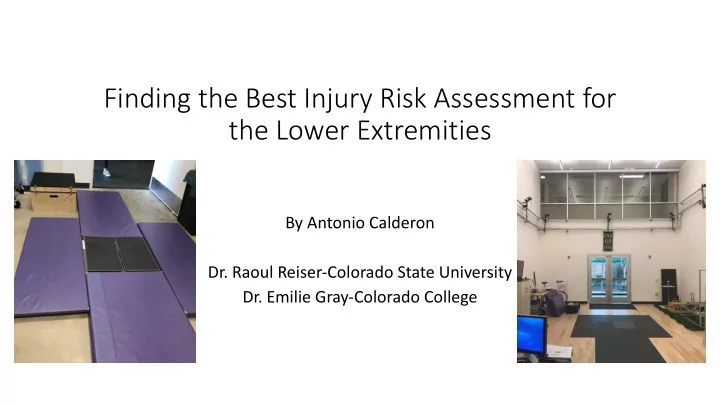

Finding the Best Injury Risk Assessment for the Lower Extremities By Antonio Calderon Dr. Raoul Reiser-Colorado State University Dr. Emilie Gray-Colorado College
Sports Injuries: An Epidemic • Huge cost and burden • $1.8 billion/year in school-age children • Single Big 10 Institution: 1317 injuries across 4 years
Limb Asymmetries • Measurable difference in performance/function between L/R limbs • Hamstring strains • Lower back pain • ACL tears
Functional Movement Assessments • Simple, repeatable movements that may reveal risky biomechanics • Kinetic Chain Theory, Force Platforms 3 categories of FMAs: 1. Drop Jump (DJ)
à à à 1 2 3 4 à Drop Jump (DJ) 5
Functional Movement Assessments cont. 2. Countermovement Jump w/ Rebound (CMJR)
à à à 4 1 3 2 à Countermovement Jump with ß Rebound Jump (CMJR) 6 5
Functional Movement Assessments cont. 3. Single-leg Countermovement Jump (SL CMJ) à à à 1 2 3 4
Braking vs. Propulsive Movements • Braking: muscle lengthening under load (“resisting”) • Propulsive: muscle shortening under load (“contracting”) • Measuring asymmetry in both phases of movements à more info about injury risk Braking Propulsive
• Past research in muscle activation/neurological control • Each phase/movement type should be categorized! • Braking Phase vs. Propulsive Phase • Unilateral vs. Bilateral (Sismek, 2017) Electrode placement during muscle activation analysis Muscle Activation Patterns
Research Questions 1. Are 4 functional movement assessments 2. Do we get any additional information by dividing interchangeable? (DJ, CMJ (countermovement jump), these movements into braking and propulsive RBJ (rebound jump ), SL CMJ ) phases? -------------------------> -------------------------- -----------------------> -----------------------> DJ DJ -------------------------> CMJ -------------------------> Etc. (x2) CMJR RBJ ------------------------> SL CMJ SL CMJ
Example Graphs Hypotheses (Bilateral Movement) • 3 Bilateral Movements will Asymmetries correlate strongly (Bilateral Movement) Asymmetry • Unilateral Movements (SL CMJ) (Bilateral Movement) will correlate weakly with Bilateral Asymmetries movements (DJ, CMJ, RBJ) SL CMJ Asymmetries • Braking Force will correlate weakly Propulsive Force with Propulsive Force Asymmetries Braking Force Asymmetries
Methods • N=104, 3 jump types (DJ, CMJR, SL CMJ), 3 trials each • 4 movements analyzed: DJ, CMJ, RJ, SL CMJ • Pearson’s Correlations • R>0.5 = Strong • 0.3<R<0.5 = Moderate • R<0.3 = Weak
Results: Bilateral vs. Bilateral Propulsive 10 5 Drop Jump Propulsive 0 -15 -10 -5 0 5 10 15 -5 -10 -15 Countermovement Jump Propulsive R = 0.679 (CMJ – DJ) 0.660 (RBJ – DJ) 0.708 (CMJ – RBJ) ALL STRONG CORRELATIONS
Results: Bilateral vs. Bilateral Braking 30 Drop Jump Braking 25 20 15 10 5 0 -20 -10 0 10 20 30 40 -5 -10 -15 -20 Rebound Jump Braking R = .573* (RBJ – DJ) *only correlation we were able to make in this ALL STRONG CORRELATIONS category
Results: Unilateral (SL CMJ) vs bilateral propulsive 10 5 Drop Jump Propulsive 0 -10 -8 -6 -4 -2 0 2 4 6 8 10 12 -5 -10 -15 R = .350 Single Leg Countermovement Jump Propulsive (SLCMJ – DJ) .321 (SLCMJ - CMJ) .278 (SLCMJ – RBJ) ALL MODERATE/WEAK CORRELATIONS
Results: Propulsive vs. Braking 10 5 Drop Jump Propulsive 0 -20 -15 -10 -5 0 5 10 15 20 25 30 -5 -10 -15 Drop Jump Braking R = .485* (DJ) .440* (RBJ) *-only were able to ALL MODERATE CORRELATIONS make two correlations in this category
Conclusions Conclusion(s) Research Question • - Bilateral movements correlate 1. Are any functional movement strongly à potentially assessments interchangeable? interchangeable • - Bilateral vs. Unilateral correlate weakly à not interchangeable ________________________________________________________________________________________________ 2. Any additional info from • - Yes. Braking vs. Propulsive moderately correlated à not dividing into braking and interchangeable propulsive? *All movements and phases provide unique information à should be used together*
Genetic Basis for Functional Asymmetry • Early developmental signaling pathways à L/R body asymmetry à “handedness” • Handedness could be associated with: • Asymmetry in muscular strength • Asymmetry in neuromuscular control Signaling Pathway for Handedness
Other Important Factors to Consider • Leg-Length Asymmetry • Adaptive Asymmetries in certain sports • Baseball, Australian Football, Cricket Fast Bowlers
Future Directions • Address limitations: control for prior activity, warmup type/duration, obtain medical records • Larger sample size to perform inter-class correlations • Sex-Specific/Sport- Specific/Position-specific • Leg-length asymmetry classes • Measure limb strength and neurological control (Cazzola, 2010) • 3-D motion capture (Kinematic Variables)
Acknowledgements • Dr. Raoul Reiser, Dept. of Health and Human Sciences, Colorado State University • Dr. Emilie Gray, Dept. of Organismal Biology and Ecology, Colorado College • Colorado State University Dept. of Athletics • Colorado State University Dept. of Health and Human Science • Gabrielle Hess, Caitlyn Helwig, Ross Lohrich • Colorado College Dept. of Organismal Biology and Ecology
THANK YOU! Any questions please let me know: t_calderon@coloradocollege.edu
Supplemental Equations, etc. • Asymmetry Equation: (((Left limb force-Right Limb force)/((0.5)*(Right limb force+Left limb force)))*100=% asymmetry
Recommend
More recommend